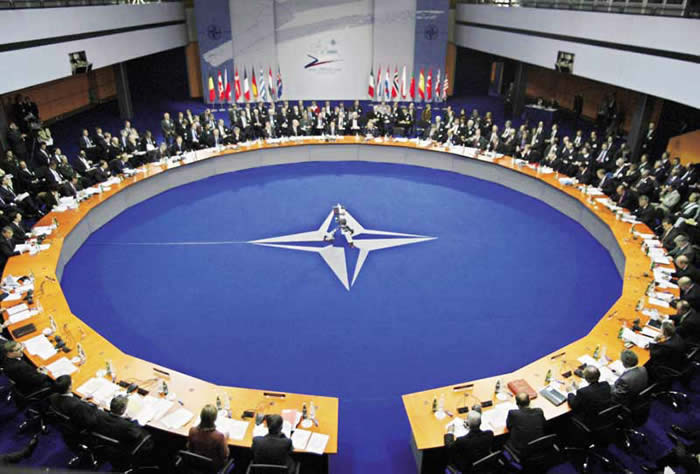When members of a strained Alliance convene in Strasbourg, France and Kehl, Germany for the 60th Anniversary of NATO it will have been a decade since they last agreed upon a strategic vision for the alliance.
This will also be President Obama’s first international security summit with members of the Alliance and it will be a pivotal for shaping the future of the organization. As the countries gear up for the Summit, there will be discussions on NATO’s presence and capabilities in Afghanistan, the possibility of future enlargement — starting with the status of potential member states Georgia and the Ukraine — and how NATO may contribute to the global energy crisis or develop cyber security programs. However, there will be another discussion that will be much more critical for the future of the Alliance: developing NATO’s new Strategic Concept. In doing so, NATO members will have an opportunity to answer the question many have been asking, what is NATO’s purpose and role in the 21st Century.
In its symbolic role, NATO represents the agreement of twenty-six countries in North America and Europe “that an armed attack against one or more of them in Europe or North America shall be considered an attack against them all and consequently they agree that, if such an armed attack occurs, each of them, in exercise of the right of individual or collective self-defense recognised by Article 51 of the Charter of the United Nations, will assist the Party or Parties so attacked by taking forthwith, individually and in concert with the other Parties, such action as it deems necessary, including the use of armed force, to restore and maintain the security of the North Atlantic area.” It is, by its nature, the very meaning of deterrence, a concept that shaped the global environment throughout the Cold War. However, as the environment has shifted to threats that are not as well defined or politically agreeable by all Alliance members, NATO’s symbolic meaning has in itself been called into question.
Its functional role is to “safeguard the freedom and security of all its members by political and military means.” To do so, the Alliance indentified in the 1999 Strategic Concept ways in which it could operate in an environment of “continuing change.” It recognized the importance of maintaining an open dialogue with Ukraine, Russia, and Mediterranean countries, the continued process of enlargement, the problems of nuclear proliferation, and a commitment of conflict prevention and crisis management. In order to support this functional role, the concept noted that the NATO forces should maintain the ability to respond to Article V and non-Article V crises. However, as a consensus-based decision-making organization, the Alliance became strained as threat perceptions diverged, especially with regards to the current operations in Afghanistan, where the U.S. sees itself as fighting a war and its European counterparts see themselves as being confronted with a humanitarian crisis.
Since 1999, some have argued that the attacks of September 11; the ongoing war in Afghanistan; the U.S.-led invasion in Iraq and subsequent reconstruction effort; and terrorist attacks in London, Madrid and Mumbai each respectively changed everything. For NATO, this means that it is not only necessary to define its symbolic purpose in the new international security environment as it develops a new Strategic Concept, but its functional purpose as well. Adapting to new perceptions and a new physical environment has proven to be extremely difficult for the consensus-based organization, mainly a result of the historical representation that NATO encompasses and the general differences between Alliance members.
In order to prepare a new Strategic Concept, NATO members must first understand and agree on what the Alliance represents today and how it needs to develop its military capabilities to function in line with what NATO represents. There is no better example as to where interests and understandings of NATO’s symbolic purpose and its capabilities diverge more than the current mission in Afghanistan. Here, the U.S. has clearly stated that it not only finds the mission in Afghanistan to be of critical importance for the war on terror, but it also links the security of Afghanistan to its own. In Europe, where the conflict in Afghanistan is mainly considered a humanitarian crisis and not as closely linked to European security, differs greatly with its general perception of the war. In turn, the national governments have not aptly defined how NATO should function in this war or humanitarian crisis, as they cannot agree on basics of the crisis.
As the Alliance approaches its summit in April, European member states should be prepared for another request by the U.S. for greater support for the war effort in Afghanistan. However, as the Strategic Concept is being developed, member states should also begin thinking about the role of the Alliance as a whole, symbolically and functionally, before making any such decisions on NATO’s role in crises, including Afghanistan. In rethinking NATO’s Strategic Concept, the U.S. and its European counterparts will have the opportunity to redefine NATO and how they see the Alliance, both functionally and symbolically, in the 21st Century.
David Capezza is a consultant to The Center for a New American Security in Washington, DC.
Image: NATO-meeting.jpg
